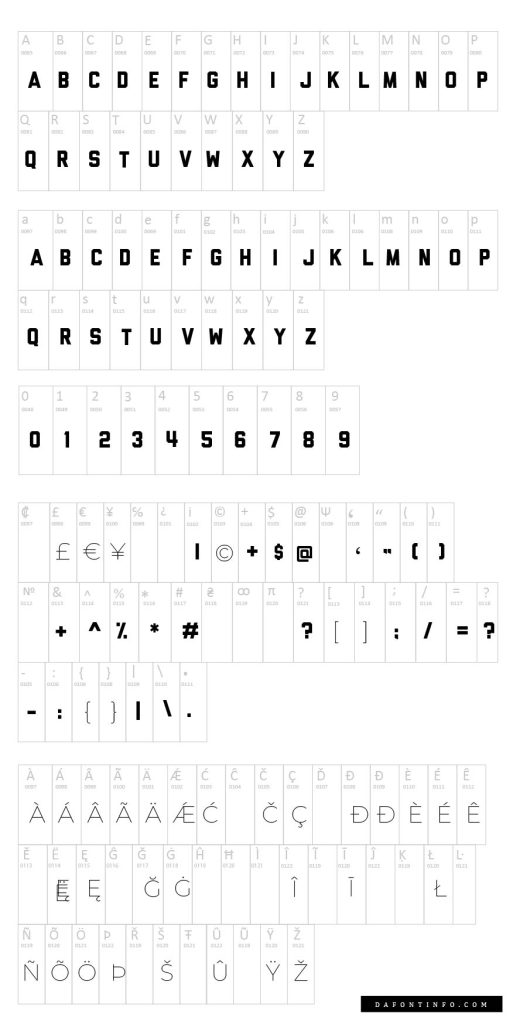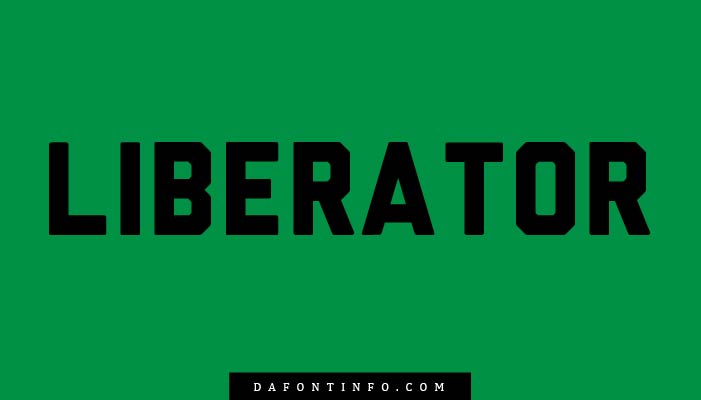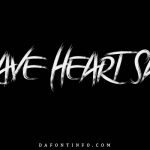Liberator Font
Ryan Clark designed the display typeface Liberator Font in 2011. It draws inspiration from the bygone era of industrial machinery and war propaganda posters.
Apple Kid Font Free Download
Its shapes are simple and geometric, giving it a powerful and striking appearance. It works well for projects that call for a retro and masculine touch, such as headlines, logos, posters, and other designs. Only personal use of the Liberator Font is free; commercial use requires the purchase of a license.
Information table
| Font name | Liberator Font |
| Style | Display |
| Designer | Ryan Clark |
| File Format | OTF, TTF |
| Font license | Free for personal use, commercial license |
| Type | Sans-serif |
| Publisher Date | 2011 |
Reason to use of Liberator Font
There are several reasons why one might choose to use the Liberator Font in their design projects:
- Simple geometric shapes and clean lines give it a modern, timeless look that is adaptable and simple to read. This design is clean and modern.
- High legibility: The font’s clean design makes it highly legible, even in small sizes.
- The font’s retro and masculine vibe is derived from the bygone era of industrial machinery and war propaganda posters. Its robust and striking appearance gives any project a retro, manly feel.
- Versatility: The typeface is appropriate for a wide range of applications, including posters, headlines, logos, and other designs that need to have a strong, imposing presence.
- Free for personal use: A license is required for commercial use; the font is free for personal use only. It is available for download from a number of websites, including Dafontinfo.com.
Use Cases
Some possible use cases of Liberator Font are:
- Designs for logos: You can use this typeface to make unique and memorable logos for your business, product, or brand. You could use it to create a logo for a sports team, vintage clothes shop, or video game with a military theme.
- Sport labels: With this typeface, you can design vibrant, dynamic labels for your sporting goods, like helmets, jerseys, stickers, and posters. You can use it, for instance, to make a label for a skateboard, a racing car, or a football team.
- Clothing: You can use this typeface to design chic and current clothing items like t-shirts, hoodies, coats, and caps. You could use it to design a hat with an attention-grabbing phrase, a hoodie with a vintage logo, or a t-shirt with a motivational quote.
- Printing projects: Flyers, brochures, banners, and invitations are just a few of the eye-catching and visually appealing printing projects you can make with this font. You can use it, for instance, to make an invitation for a birthday party, a brochure for a travel agency, or a flyer for a music festival.
- Posts on social media: You can use this font to make interesting and visually appealing posts on social media, like pictures, videos, reels, and stories. You can use it, for instance, to make a funny meme image, an animated video, or a narrative with a whimsical filter.
Characteristics

Some characteristics of Liberator Font are:
- It is a display typeface that was created by Ryan Clark in 2011.
- It is inspired by the vintage era of war propaganda posters and industrial machinery.
- It has a strong and bold appearance, with simple and geometric shapes.
- It is suitable for headlines, logos, posters, and other projects that require a retro and masculine touch.
- It is free for personal use only, and you need to purchase a license for commercial use.
- It is available in three weights: Heavy, Medium, and Light.
- It has more than 120 characters, including uppercase, lowercase, marks, and numbers.
- It has a high legibility, even in small sizes.
- It has a clean and modern design, with some modern touches.
- It has a sans-serif type, with no curves or serifs.
Review of Liberator Font
A display typeface with a retro and military aesthetic is called Liberator. Ryan Clark created the design, and it was released in 2011. It features ligatures, punctuation, numbers, uppercase, lowercase, and one standard weight. For personal use only, it is free; for commercial use, a license is needed.
Some of the features and characteristics of the Liberator font are:
- It has a solid and fine texture, with hard lines and simple curves. It is suitable for creating book covers, unique emblems, game graphics, product designs, and special event cards
- It is metrically compatible with the Arial font, which means that the letters and symbols have the same width and height. This allows for easy substitution without changing the document layout
- It has a masculine and authoritative look, with a lot of condensed characters. It also has some modern touches, such as the rounded corners and the diagonal cuts. It makes things clear and gets people’s attention, which is important for important information or instructions
- It is not recommended for small-size screen displays and for long texts, as it may lose its readability and impact. It is best used for headlines, logos, posters, and banners
- It has a distinctive, vintage-inspired look that effortlessly blends strength and sophistication. This versatile typeface provides a wide range of design possibilities, allowing for the creation of eye-catching projects with a commanding presence
Character Map

Alternative font of Liberator Font
Liberator is a display typeface with a retro, military-inspired appearance that is comparable to many other fonts. You can download and use the following free fonts for personal projects:
- Pop Warner: This font has a strong and sporty look, with sharp edges and thick strokes. It is suitable for creating logos, headlines, and posters that need to stand out.
- Jersey M: This font has a retro and athletic look, with rounded corners and slanted cuts. It is suitable for creating team names, numbers, and slogans that need to evoke a sense of nostalgia and pride.
- Piston Pressure: This font has a futuristic and industrial look, with metallic effects and diagonal lines. It is suitable for creating sci-fi, cyberpunk, and steampunk-themed designs that need to convey a sense of power and speed.
- High-Jakarta: This font has a modern and minimalist look, with simple shapes and clean curves. It is suitable for creating elegant, sleek, and sophisticated designs that need to convey a sense of style and professionalism.
- NFL Minnesota Vikings: This font has a bold and dynamic look, with angular edges and pointed tips. It is suitable for creating sports, adventure, and action-themed designs that need to convey a sense of energy and excitement.
Comparison Of Liberator Font
You can download and utilize a variety of Liberator-like fonts for your own projects. Using the web search tool, I was able to locate a few free fonts, which are:
- Pop Warner: This font has a strong and sporty look, with sharp edges and thick strokes. It is suitable for creating logos, headlines, and posters that need to stand out.
- Jersey M: This font has a retro and athletic look, with rounded corners and slanted cuts. It is suitable for creating team names, numbers, and slogans that need to evoke a sense of nostalgia and pride.
- Piston Pressure: This font has a futuristic and industrial look, with metallic effects and diagonal lines. It is suitable for creating sci-fi, cyberpunk, and steampunk-themed designs that need to convey a sense of power and speed.
- High-Jakarta: This font has a modern and minimalist look, with simple shapes and clean curves. It is suitable for creating elegant, sleek, and sophisticated designs that need to convey a sense of style and professionalism.
- NFL Minnesota Vikings: This font has a bold and dynamic look, with angular edges and pointed tips. It is suitable for creating sports, adventure, and action-themed designs that need to convey a sense of energy and excitement.
Tips and Tricks
Some of the tips and tricks for using Liberator font are:
- Use it for graphics such as banners, posters, logos, and headlines that must have a powerful presence. Liberator features clean, crisp lines and straightforward curves. It draws attention and clarifies things, both of which are crucial for crucial information or instructions.
- Combine it with other sans-serif fonts that are stylistically complementary or dissimilar. Liberator’s characters and symbols have the same width and height as the Arial font because it is metrically compatible with it. This makes replacement simple and doesn’t require modifying the document layout. It can also be combined with other fonts like High-Jakarta, Piston Pressure, or Evogria which have a contemporary, minimalist, or futuristic appearance.
- To further accentuate the font’s retro and military vibe, incorporate some vintage effects or textures. Liberator has a unique, retro-inspired style that skillfully combines toughness and refinement. You can give your designs a grungy, rusty, or worn-out appearance by using overlays, brushes, and filters.
- Try varying the weights, sizes, and colors to produce a design that is both dynamic and adaptable. Liberator features many angular and diagonal cuts, giving it a bold and compact appearance. To make a distinctive and striking design, experiment with various thicknesses, spacing, and alignment levels. Additionally, you can use color to emphasize, create harmony, or create contrast.
How to Copy and Paste Liberator Font?
Liberator is a condensed, bold typeface whose conceptual inspiration comes from the vintage period. Its straight lines and straightforward curves give it a manly, authoritative appearance. It has capital letters, numerals, punctuation, and ligatures and comes in three weights. For personal use only, it is free; for commercial use, a license is needed.
To copy and paste the Liberator font, you can follow these steps:
- Visit the website that offers the Liberator font for download, such as Dafontinfo.com.
- Click on the download button and save the ZIP file to your computer.
- Extract the ZIP file and open the folder that contains the Liberator font files.
- Right-click on the font file that you want to use (Liberator-Regular.otf, Liberator-Bold.otf, or Liberator-Heavy.otf) and select Install.
- Open the application or website where you want to use the Liberator font, such as Instagram, Twitter, TikTok, or anywhere you want.
- Type or paste the text that you want to convert into the Liberator font.
- Select the text and change the font to Liberator from the font menu or settings.
- Copy the text and paste it wherever you want.
Liberator Font Style
This passage demonstrates the use of the Liberator font style. It is a strong and striking typeface that works well for a variety of designs, including banners, posters, headlines, logos, and more.
It reminds me of old-fashioned industrial signs and propaganda posters from the war years. It is appropriate for tasks requiring a powerful and lasting impression.
You can get the Liberator font style for free from websites like Dafontinfo.com. if you wish to use it. Additionally, you can use an online font generator tool like [LingoJam], [Copy And Paste Fonts], [Fotor], or [Fansy Font] to transform regular text into various text fonts that you can copy and paste.
Liberator and other related fonts are among the many font styles available for these tools. Nevertheless, not all platforms and devices may be compatible with these tools, and some may have restrictions on the amount of characters or symbols you can use.
How to use Liberator Font in Canva?
With Canva, a well-known online design tool, you can make amazing logos, posters, and other visuals. You will need a Canva Pro account, which grants you access to additional features and fonts, in order to use the Liberator font in Canva. Liberator is just one of the fonts you can upload to Canva Pro. To use the Liberator font in Canva, follow these steps:
- The Liberator font must first be downloaded from a website that provides it for free, such as Dafontinfo.com. Before downloading, make sure you have permission to use the font for the intended use and review the license terms.
- The font file must then be unzipped and installed on your computer. Right-click on the font file and choose Install to accomplish this. As an alternative, you can drag and drop the font file into your computer’s Fonts folder.
- Then, you need to log in to your Canva Pro account and open your design. You can upgrade your current Canva Pro account or create a new one if you don’t already have one.
- The Brand Kit tab on the left sidebar must then be accessed. You can upload and manage your brand’s logos, colors, and fonts here. At the bottom of the Brand Fonts section, click the Upload a Font button. You will be prompted to verify that you are authorized to use the font. After selecting the checkbox, click the Upload font button.
- Lastly, choose the font file you wish to upload, then press the Open button. You can use the font in your design after it is added to your Brand Fonts. Selecting the desired text and selecting the Liberator font from the Font Family dropdown menu will accomplish this.
Liberator Font Symbol
Liberator font is a condensed, bold typeface with conceptual roots in the vintage era. Its straight lines and straightforward curves give it a manly, authoritative appearance. It has capital letters, numerals, punctuation, and ligatures and comes in three weights. For commercial use, a license is needed; it is free for personal use only.
The name of the font family that includes the Liberator font is represented by the Liberator font symbol. It refers to the font as a whole rather than a particular character or glyph. The font family names Arial, Times New Roman, and Courier New, which also have a variety of styles and weights, are comparable to the symbol of the Liberator font.
The Liberator font symbol has nothing to do with Liberation fonts, which are a distinct collection of fonts that are metrically compatible with the most widely used fonts on Windows and Office. Unlike Liberator font, which only supports the Latin, Greek, and Cyrillic alphabets, Liberation fonts are open-source and have a greater Unicode coverage.
How to use Liberator Font in Photoshop?
Photoshop is a strong and adaptable program that lets you make and modify graphics, images, and designs. The Liberator font can only be used in Photoshop if you first download and install it on your PC, after which you can choose it from the font menu. The Liberator font can be used in Photoshop by following these steps:
- The Liberator font must first be downloaded from a website that provides it for free, like Dafont Free. Before downloading, make sure you have permission to use the font for the intended use and review the license terms.
- The font file must then be unzipped and installed on your computer. Right-click on the font file and choose Install to accomplish this. As an alternative, you can drag and drop the font file into your computer’s Fonts folder.
- After that, you must launch Photoshop and either open or create a new document. If you’d like, you can also use a template or preset.
- Next, you have to hit the T key on your keyboard or choose the Text tool from the toolbar. To add text, click on the document and either type or paste your text.
- Lastly, you must pick the text and use the font menu at the top to change the font to Liberator. Additionally, you can change the font’s size, color, alignment, and other settings to your preference.
Liberator Font Family

The Liberator font family consists of five fonts with similar features and design aesthetics. Ryan Clark is a New York-based illustrator and graphic designer who created the Liberator font family.
The vintage era, particularly the industrial signs and war propaganda posters, served as inspiration for him. His goal was to design a typeface with simple curves and sharp lines that exude strength and masculinity.
The Liberator font family is appropriate for a variety of applications, including headlines, posters, banners, logos, and more that require a strong visual impact.
The liberator font family consists of the following fonts:
- Liberator Regular: This font family’s foundational style. It has a strong, unyielding aesthetic with fully controlled letterforms and distinctive details. It is perfect for making messages stand out from the background by being bold and clear.
- Liberator Bold: This is the regular font in a thicker, heavier version. Its greater weight and contrast give the text more authority and impact. It is perfect for creating strong and dominant headlines and titles that grab the attention of the viewers.
- Liberator Italic is a version of the standard font that is slanted and oblique. Its subtle curvature and tilt give the text more energy and movement. It works well for writing text that is passionate and expressive and exudes urgency and action.
- The darkest and heaviest font in the family is called Liberator Heavy. Its extreme intensity and density give the text a dramatic, attention-grabbing effect. It works well for writing text that is strong and commanding, deserving of respect and appreciation.
- Liberator Medium: This font family version is balanced and medium in size. Its text is fluid and elegant because of its moderate and harmonic style. It works well for crafting elegant and complex writing that exudes professionalism and high caliber.
The Liberator font family costs nothing for personal use and needs a license for business use. It is available for free download from a number of websites, including Dafontinfo.com.
Liberator and other related fonts are among the many font styles available for these tools. Nevertheless, not all platforms and devices may be compatible with these tools, and some may have restrictions on the amount of characters or symbols you can use.
Supported Languages
supports the following languages:
- Abkhaz
- Afrikaans
- Albanian
- Alsatian
- Aragonese
- Arapaho
- Aromanian
- Arrernte
- Asturian
- Aymara
- Azerbaijani (Cyrillic)
- Bashkir
- Basque
- Belarusian
- Belarusian (Lacinka)
- Bislama
- Bosnian
- Breton
- Bulgarian
- Buryat (Cyrillic)
- Catalan
- Cebuano
- Chamorro
- Chechen
- Cheyenne
- Chichewa (Nyanja)
- Chuvash
- Cimbrian
- Corsican
- Croatian
- Cyrillic
- Czech
- Danish
- Dungan
- Dutch
- English
- Esperanto
- Estonian
- Evenki (Cyrillic)
- Faroese
- Fijian
- Finnish
- French
- French Creole (Saint Lucia)
- Frisian
- Friulian
- Galician
- Genoese
- German
- Gilbertese (Kiribati)
- Greek
- Greenlandic
- Guarani
- Haitian Creole
- Hausa
- Hawaiian
- Hiligaynon
- Hill Mari
- Hmong
- Hopi
- Hungarian
- Ibanag
- Icelandic
- Iloko (Ilokano)
- Indonesian
- Interglossa (Glosa)
- Interlingua
- Irish (Gaelic)
- Istro-Romanian
- Italian
- Jèrriais
- Kabardian
- Kalmyk (Cyrillic)
- Karachay (Cyrillic)
- Kashubian
- Kazakh (Cyrillic)
- Khakas
- Khalkha
- Kirundi
- Komi-Permyak
- Kurdish
- Kurdish (Kurmanji)
- Kyrgyz (Cyrillic)
- Ladin
- Latvian
- Lithuanian
- Lojban
- Lombard
- Low Saxon
- Luxembourgian
- Macedonian
- Malagasy
- Malay (Latinized)
- Maltese
- Manx
- Maori
- Meadow Mari
- Megleno-Romanian
- Míkmaq
- Mohawk
- Moldovan
- Nahuatl
- Nenets
- Norfolk/Pitcairnese
- Northern Sotho (Pedi)
- Norwegian
- Occitan
- Oromo
- Ossetian
- Pangasinan
- Papiamento
- Piedmontese
- Polish
- Portuguese
- Potawatomi
- Quechua
- Rhaeto-Romance
- Romanian
- Romansh (Rumantsch)
- Rotokas
- Russian
- Rusyn
- Sami (Inari)
- Sami (Lule)
- Sami (Northern)
- Samoan
- Sardinian (Sardu)
- Scots (Gaelic)
- Serbian (Cyrillic)
- Serbian (Latin)
- Seychellois Creole (Seselwa)
- Shona
- Sicilian
- Slovak
- Slovenian (Slovene)
- Somali
- Southern Ndebele
- Southern Sotho (Sesotho)
- Spanish
- Swahili
- Swati/Swazi
- Swedish
- Tagalog (Filipino/Pilipino)
- Tahitian
- Tajik
- Tatar (Cyrillic)
- Tausug
- Tetum (Tetun)
- Tok Pisin
- Tongan (Faka-Tonga)
- Tswana
- Turkmen
- Turkmen (Cyrillic)
- Turkmen (Latinized)
- Tuvaluan
- Tuvin
- Udmurt
- Ukrainian
- Ulithian
- Uyghur (Cyrillic)
- Uyghur (Latinized)
- Uzbek (Cyrillic)
- Veps
- Vietnamese
- Volapük
- Votic (Cyrillic)
- Votic (Latinized)
- Walloon
- Warlpiri
- Welsh
- Xhosa
- Yakut/Sakha
- Yapese
- Zulu
Conclusion
The display typeface Liberator has a robust, vintage aesthetic. It draws inspiration from the bygone era of industrial machinery and war propaganda.
It works well for producing catchy headlines, logos, posters, and other visual designs that require a strong, unique style. The three weights of the Liberator font are regular, bold, and italic.
It can handle ligatures, punctuation, numbers, and uppercase letters. For commercial use, a license is needed; it is free for personal use only. Ryan Clark created the Liberator font, which Adobe Systems published in 2011.
FAQ
Who designed the Liberator Font and when was it created?
The Liberator Font was designed by Ryan Clark in 2011.
What inspired the design of the Liberator Font?
The font draws inspiration from the vintage era of industrial machinery and war propaganda posters.
What type of font is Liberator?
Liberator is a display typeface, specifically designed for headlines, logos, posters, and other projects that require a strong and striking appearance.
Is Liberator Font free to use?
Yes, the Liberator Font is free for personal use. However, a license is required for commercial use.
In what file formats is Liberator Font available?
Liberator Font is available in OTF (OpenType) and TTF (TrueType) file formats.
What is the publisher date of Liberator Font?
Liberator Font was published in 2011.
What are the characteristics of a Liberator Font?
Liberator Font has simple geometric shapes, clean lines, a retro and masculine vibe, high legibility, and a versatile design suitable for various applications.
How many weights does Liberator Font have?
Liberator Font is available in three weights: Heavy, Medium, and Light.
Can I use the Liberator Font for commercial purposes?
No, commercial use of Liberator Font requires the purchase of a license.
Where can I download Liberator Font?
Liberator Font can be downloaded from various websites, including Dafontinfo.com.
What are some use cases for Liberator Font?
Liberator Font is suitable for logos, sports labels, clothing designs, printing projects, and social media posts, among other applications.
Are there alternative fonts similar to Liberator?
Yes, some alternative fonts include Pop Warner, Jersey M, Piston Pressure, High-Jakarta, and NFL Minnesota Vikings.
How can I use Liberator Font in Canva?
To use Liberator Font in Canva, you need a Canva Pro account. Download the font, unzip the file, install it on your computer, and upload it to Canva through the Brand Kit.






